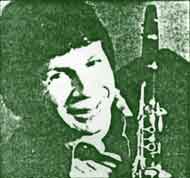ARTICLES
(Classical Music)
Published in ‘Classical Music’ April 1989
| | | NEXT ARTICLE > |
|
WINDS
OF CHANGE
John Greenhalgh meets two men who are putting woodwind at the front of the orchestra. |
|
Daniel
Smith with his bassoon and Richard Stoltzman
with his clarinet are part of a relatively
new phenomenon - classical wind players
who have forged international careers for
themselves as solo performers.
Forty years ago the genre did not
exist. ‘Up until the 1950s,’ alleges Smith,
‘there was no classical musician who had
a worldwide career playing a solo wind instrument.
‘Figures like Eugene Goossens, great as they were, did not attain the worldwide status that James Galway or Jean Pierre Rampal has today. Thus, it was inconceivable for managers, orchestras or concert societies to think of a wind player going out on the platform and for an hour or two holding the attention of an audience in the way a violinist or pianist could. Of course, people did step out of the orchestras and play solo wind instruments but no one classical performer had a career as such. Rampal changed all that. He opened up a market, he was followed by specialist players in oboe, flute, clarinet and trumpet. Logically, why not the bassoon, too? That's where I came in.
Stoltzman puts it differently. ‘Years ago,’ he says, ‘everyone assumed that if you were a clarinettist you would audition for an orchestra. Perhaps do some teaching and perhaps play from time to time in the Brahms Quintet or other such eloquent music for the clarinet. Benny Goodman, who was the apotheosis of clarinet playing, was surprised that I wanted to be simply a solo recitalist. But, it is a vocation for me and I don’t teach or do anything else for a living.’ The clarinet was Stoltzman’s chosen instrument from a young age. By comparison, Smith came to the bassoon very late in the day. ‘I have the oddest background as a bassoon player. I didn’t take up the instrument until I was 24. I began with the clarinet when I was 16, took up the saxophone a year later and finally the flute at the Manhattan School of Music in New York. During my army service, which followed university, I was a solo piccolo player but had also started to double up on the bassoon. Gradually the bassoon took over.
|
The bassoon, however, has a long way to go to catch up with the clarinet in terms of popularity, although it is a much older instrument historically. ‘In the mind of a 20th century person, the clarinet is very much associated with dixieland, swing and jazz’ says Stoltzman. ‘If you were to ask the man-in-the-street to name the most famous clarinet player of the century, I suspect Benny Goodman would be the answer! ‘Goodman has been an inspiration to me, as has Aaron Copeland, who wrote his clarinet concerto for me. There is a wealth of new music too since written for clarinet. There are Takemitsu and Lukas Foss concertos for me in the pipeline. Works such as the Boulez Domaines and Dialogues and a Steve Reich work for 11 clarinets are fine pieces, but there’s much more besides. I think one of the noblest things about being a musician is being part of a creative process which goes on and on in time into the 21st century and beyond.’ The bassoon also is gradually receiving more attention from present day composers. ‘Music by Panufnik and Gordon Jacob is well known, as is Gunther Schuller’s contrabassoon concerto’ says Smith. His instinct is that the time is ripe for the instrument to grow in popularity. ‘There are signs that it’s already happened. There are more good bassoon players around than there are jobs.’ Smith shares the market with such players as Kim Walker, who has done much pioneering work to establish the bassoon as a solo instrument, as her recordings bear eloquent witness. The good players - in Germany and Austria - are not known because the instrument itself is not that well known, says Smith. ‘I have to admit that the majority of people have no idea what the bassoon can sound like. Its versatility is unknown to them. They often think of it as ponderous. They know what it looks like, perhaps, but they have no idea of its range and repertoire. I’ve helped potential audiences here by playing and recording, with the RPO, Bassoon Bons-Bons, “crossovers” - arrangements of pieces like La Donna É Mobile and Golliwogg’s Cakewalk. Smith’s major on-going recording project is the 37 Vivaldi concertos with the ECO. This month sees The release of the third disc/cassette/CD in the series of six. Like Smith, Stoltzman spends most of his year touring, at least between September and June. ‘The chamber music audience is very loyal, but it’s also very disparate he says, ‘and I go to where the people who want to hear Brahms or Poulenc or Schumann are. When they’ve had their fill, I move on to the next place.’ He does spend three weeks a year with TASHI, the group he formed 15 years ago, and with which there is a special and continuing creative relationship. ‘The most wonderful thing about chamber music is that you never get tired of playing the same great works.’ The Amadeus and the Beaux Arts would have concurred. APRIL 1989 |
